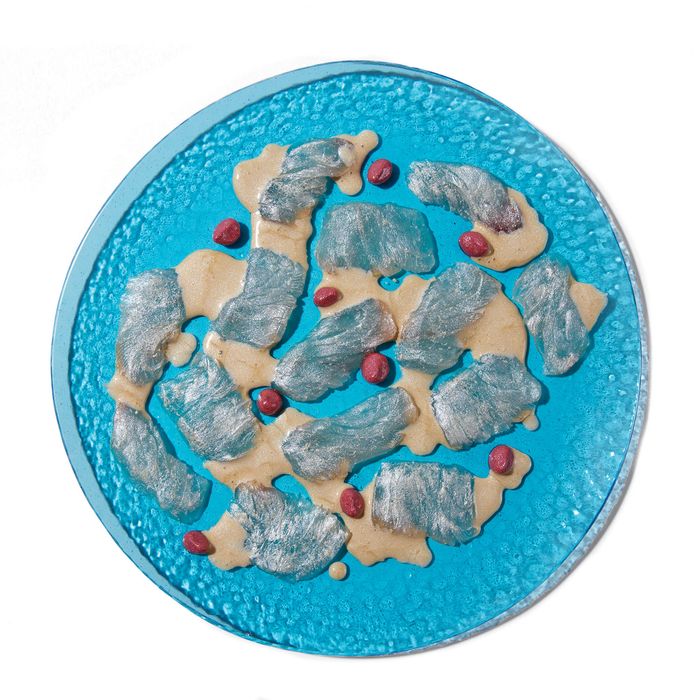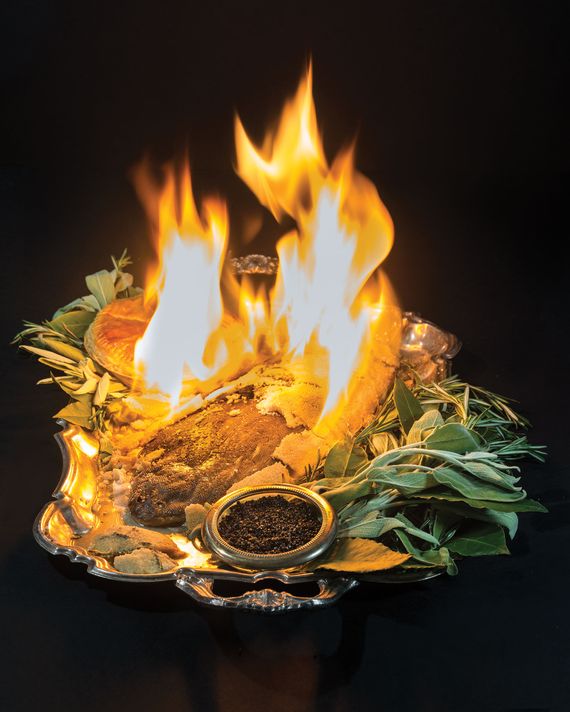
Ocean life is dwindling, climate change could wreak havoc on our crops, and the massive environmental toll of livestock is only now being fully understood. Given this, and the constant cycle of ever-changing tastes and technology, we wanted to know what our food might look like in ten years’ time. So, for New York’s Future Issue, we asked New York City’s cutting-edge chefs to imagine “dinner” in 2029. Here’s what they think we’ll see (and eat).
Unicorn-trout crudo with omni garum and toasted spelt milk (above), by Alex Stupak
Stupak, the chef and owner of the Empellón restaurant group, imagines a future that is both bleak and rainbow-colored. “Everyone wants to feel like everything is going to be okay,” he says, “so soft fluffy wording is huge in 2029.” Unicorns, yummy, rainbows, sparkles: These words are the “local” and “artisanal” of future marketing.
At the same time, resources will dwindle and the ingredients that remain plentiful — like invasive species of fish, which will become vital parts of the food chain — will be renamed. “Did you know the original name for Chilean sea bass is Patagonia tooth fish?” Stupak asks. Rebranding is already common, and “ten years into the future it will become vital.”
So he offers a dish of raw “unicorn trout ” — lionfish, perhaps — dressed in a fermented sauce of foods that might otherwise be thrown out, arranged in a pool of spelt milk. In 2029, Stupak says, “critics and foodies in New York will be fondly harkening back to the past reality of a city awash in fluke crudo.”
Savory bar with ancient grains, mushrooms, and seaweed, by Ignacio Mattos
“As clichéd as it might sound, I think by then we will be eating in a more rational manner,” says Ignacio Mattos, the chef whose austere, naturalistic style defines the food at his restaurants, Estela, Flora Bar, and Café Altro Paradiso. His solution: something like a sustainable, haute-cuisine energy bar. “This bar not only serves as nutritional fuel — but it’s also delicious. There are fermented-greens stems, seaweed, and quinoa. Mushrooms need to be there, too, since they play an essential role in improving human and environmental impacts.”
Seared foie gras with buttered crumpets and pickled market vegetables, by Ashley Rath
Rath, who has cooked at the Grill and Brooklyn’s Lalou, does not see actual food changing much by 2029. “What I do see changing,” she says, “is who has access to this style of food, and who controls the system that creates it.” While plant-based proteins or sustainable ingredients will be crucial for most people, the wealthiest individuals will continue to eat whatever they want — even foie gras, which is set to become banned in New York City in 2022. “This dish is delicious,” Rath says, but “unless a lot of things change politically, environmentally, and socio-economically, it also demonstrates how few people will actually have access to food like this.”
Zucchini steak with a side of sirloin, by Dan Barber
For Barber, progress is as straightforward as inverting portion sizes. The star of this dish is a squash that the chef worked to develop with Cornell plant breeder Michael Mazourek. “This is an updated version of a heirloom tromboncino squash,” Barber says. “We called it Centercut for exactly this purpose: to be in the center of the plate, so that meat is in its rightful place: on the side.”
A home-cooked meal of chef-caliber vegetables, by Suzanne Cupps
As this upcoming decade wears on, Suzanne Cupps, who will be the chef at the upcoming 232 Bleecker, sees two factors working in humanity’s favor: technology that continues to make our lives more efficient, and increased access to flavorful, high-grade produce. With more time, and better food, “people will be able to create their own dinners with simple recipes from chefs,” she explains.
So, she imagines a world where we have the time, and ingredients, to make chef-level, vegetable-forward food at home, like this composed plate of roasted kogniut squash with pumpkin-seed mole, purple barley and einkorn, and pickled aji dulce peppers; tatsoi salad with kohlrabi, radish, and date vinaigrette; and marinated badger-flame beets with dragon carrots and lemon-saffron jam.
Frog tenders, by Kia Damon
Damon, Cherry Bombe’s culinary director, took a kids’ meal as her inspiration. Her goal: Improve chicken tenders by eliminating the environmental and political problems of industrial chicken. The solution: Frogs’ legs, fried like chicken.
Dover sole en flambeé, by Angie Mar
“It’s a common joke around my table,” says Beatrice Inn chef and owner Angie Mar, “that I am actually a very old French man trapped in this body.” For her, Instagram bait will (thankfully) be vanquished in the future: “It’s so basic, and honestly incredibly boring and predictable.”
Instead, she sees 2029 as a time when chefs can double-down on timeless technique: “There are so many food trends that come and go, but I find the most comfort, insight, and soul in food that brings nostalgia with a fresh take.”
Her dish is a reinterpretation of sole meuniere, with the fish baked in a salt crust laced with laurel, rosemary and sage that’s then doused in calvados and set aflame. “There is something to be said,” Mar points out, “for the idea and elegance of timeless luxury.”
Intestine chicharron, tomato redux, fermented cabbage, by Victoria Blamey
Gotham Bar & Grill’s new chef predicts a future when, with resources exhausted, chefs have no choice but to combine creativity with social consciousness. This dish is made entirely of kitchen scraps, she says, “all animal parts, leftover veg, and produce that is no longer beautiful, but nutritious.”
Aquaponic fish buns, by Sam Yoo
Yoo, the chef behind Chinatown’s Golden Diner, imagines food that will look the same, even though the components are different. “This is a crispy fish bun similar to the fish buns they sell in Chinatown bakeries,” the chef says. “Accessible, familiar, and comforting.” The difference is that the microgreens and fish are harvested from an aquaponic farm in Bushwick, the brioche bun is made with a vegan butter substitute, and the tartar sauce starts with vegan mayonnaise to reduce the need for animal products.
Maitake mushrooms grilled in kombu with crispy mussels and kelp oil, by Diego Moya
Can sustainability be pleasurable? That’s the question that Moya, the executive chef at Racines, set out to answer with this combination. “Mussels, seaweed and cultivated mushrooms — three ingredients that will always be available. They are nutritious, plentiful and will more than likely be staples in the future.”
*A version of this article appears in the November 11, 2019, issue of New York Magazine. Subscribe Now!














